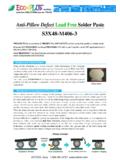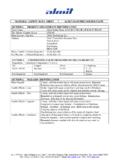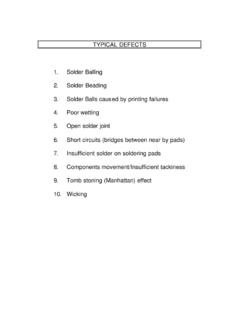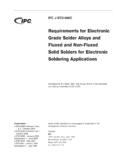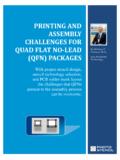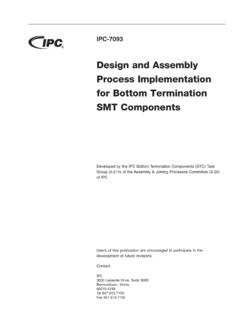Transcription of A Nickel-Palladium-Gold Integrated-Circuit Lead Finish and ...
1 Application ReportSZZA031 - December 20011A Nickel-Palladium-Gold Integrated Circuit Lead Finishand Its Potential for solder -Joint EmbrittlementDonald Abbott, Douglas Romm, Bernhard LangeStandard Linear & LogicABSTRACTThis gold (Au) embrittlement study evaluates TI s original four-layer nickel- palladium (NiPd)lead Finish that was introduced in 1989 and TI s Nickel-Palladium-Gold (NiPdAu) lead finishthat replaced four-layer NiPd in 2001. Samples were prepared with three different Authicknesses for the NiPdAu components. The printed wiring board (PWB) finishes used wereorganic solderability preservative (OSP) and electroless nickel-gold (NiAu).
2 The latter weremade with two different Au thicknesses. The goal was to understand the effect of Au from thecomponent Finish and the PWB pad Finish on Au embrittlement in the solder joint. A matrixof samples was built from the components and boards described above and exposed to 1000temperature cycles. Lead pull testing and metallurgical analysis of the solder joints wereperformed to determine if the variations in Au content, either from the lead or the board orboth, led to Au embrittlement of the solder theoretical calculations (Appendix A) showed that 3 weight % Au would not be exceededin the solder -joint test. Based on the Au embrittlement literature, this predicts no solder -jointembrittlement would occur.
3 The lead pull data showed no evidence of catastrophic drop insolder-joint strength that would be expected with Au embrittlement. The cross sections showno SnAu intermetallics in the bulk of the solder for the solder joints made with normalAu-thickness-range components and boards. Thin layers of SnAu intermetallics are seen atthe solder /component and solder /PWB interfaces. This is expected because intermetallicsform between Sn from the solder and Au from the PWB and component finishes. Only thesolder joints made with artificially high Au-thickness components and PWBs have theacicular SnAu intermetallics that have been shown to cause Au embrittlement in someinstances in the literature.
4 The NiPdAu leadframe finished components investigated for thisapplicaton report showed no measurable Au embrittlement of the solder .. Components and PWBs Tested4.. Test Matrix for Au Embrittlement4.. Reflow Profile5.. Board-Mount Equipment and Procedure5.. Theoretical Au Content Calculations5.. Predicted Au Content of solder Joints Using Thickness Data for ICs and PWBs5.. SZZA0312A Nickel-Palladium-Gold Integrated Circuit Lead Finish and Its Potential for solder -Joint EmbrittlementPerformance Measures and Results6.. Visual Appearance6.. Lead Pull Test7.. Lead Pull Data7.. Observations From Lead Pull Results8.. Statistical Analysis of Lead Pull Data8.
5 Analysis of Variance (ANOVA)8.. Box-and-Whisker Plots9.. Summary of Statistical Analysis11.. Cross Sections of solder Joints11.. Sample 6: NiPdAu Standard Finish , PWB Standard NiAu Finish11.. Sample 5: NiPd Lead Finish , PWB Standard NiAu Finish After Thermal Cycling12.. Sample 7: NiPdAu 5 Au, PWB Standard NiAu Finish After Thermal Cycling14.. Sample 2: NiPdAu Standard Finish , PWB OSP Finish After Thermal Cycling14.. Sample 10: NiPdAu Standard Finish , 5 NiAu PWB With No Thermal Cycling15.. Sample 12: NiPdAu 100 Au, PWB 5 Au Thickness After Thermal Cycling16.. Summary of Cross-Section Analysis17.. Summary and Conclusions17.
6 Acknowledgments18.. References18.. Appendix A Calculations for Au Embrittlement Study19.. List of Figures1 Structure for TI Four-Layer NiPd Finish3.. 2 Structure for NiPdAu Finish3.. 3 Reflow Profile for SnPbAg solder Alloy5.. 4 Cross Section of solder Joint6.. 5 Lead Pull Results7.. 6 Lead Pull Results by Factor-Level Setting9.. 7 Box-and-Whisker Plot for OSP Coating on PWB (No Au)10.. 8 Box-and-Whisker Plot for Standard NiAu PWB10.. 9 Box-and-Whisker Plot for PWB With 5 Au ( to )11.. 10 Sample 6 After Thermal Cycling (The Dark Gray Matrix Is the Tin-Rich Phase, While the Bright Phase Is the Lead-Rich Phase)12.. 11 Board Side of Sample 6 at 4000 After Thermal Cycling12.
7 12 Lead Side of Sample 6 at 4000 After Thermal Cycling12.. 13 Spectra of Cu, Ni, Au, and Sn Taken Along Line 1 2 in Figure 1212.. 14 1000 Image of Sample 5 After Thermal Cycling13.. 15 Board Side of Sample 5 at 4000 After Thermal Cycling13.. 16 4000 Image on the Lead Side of Sample 5 After Thermal Cycling13.. 17 Line Scan Along Line 1 2 in Figure 1613.. 18 Sample 7 at 1000 After Thermal Cycling14.. 19 1000 Image of Sample 2 After Thermal Cycling15.. SZZA0313 A Nickel-Palladium-Gold Integrated Circuit Lead Finish and Its Potential for solder -Joint Embrittlement20 1000 Image of Sample 10, No Thermal Cycling15.
8 21 Sample 10 at 4000 Board Side, No Thermal Cycling15.. 22 Sample 10 Lead Side at 4000 , No Thermal Cycling16.. 23 Line Scan Along Line 1 2 in Figure 2216.. 24 Sample 12 at 1000 After Thermal Cycling16.. 25 Sample 12 Pad Side at 4000 After Thermal Cycling16.. 26 Sample 12 Lead Side at 4000 After Thermal Cycling17.. 27 Line Scan Along Line 1 2 in Figure 2617.. List of Tables1 Group Numbers for Each Variation Tested4.. 2 Calculated Weight % Au in the solder Joints for the Test Matrix6.. 3 ANOVA Results8.. A 1 XRD/EDX Data19.. A 2 XRF/EDX Data20.. A 3 Calculations for Boards20.. A 4 Calculations for Components21.
9 A 5 Calculated Percentage of Au in the solder Joints21.. IntroductionIn 2001, TI converted from a nickel- palladium (NiPd) lead Finish for components to anickel- palladium -gold (NiPdAu) lead Finish . The NiPd Finish for IC leads was first introduced inthe late 1980s.[1,2] By October 2001, more than 40-billion NiPd-finished IC packages were inthe field. The four-layer NiPd structure is shown in Figure 1. The structure of the NiPdAu leadfinish is shown in Figure 2. The introduction of Au on the top surface of the NiPdAu leadframefinish suggested an Au embrittlement study would be Base MetalPalladium ( m min)Gold (30 to 150 )Nickel ( m min)Copper Base MetalNickel StrikePalladium/Nickel StrikeNickel ( m min) palladium ( m min)Figure 1.
10 Structure for TIFour-Layer NiPd FinishFigure 2. Structure for NiPdAu FinishA very good description of Au embrittlement is provided by Glazer et al.: Because Au hasessentially no solubility in either Sn or Pb, when the solder joint solidifies, Au is dispersedthrough the joint in the form of brittle, elongated AuSn4 or Au(SnPb)4 intermetallicprecipitates. [3] (see Figures 20 and 24)SZZA0314A Nickel-Palladium-Gold Integrated Circuit Lead Finish and Its Potential for solder -Joint EmbrittlementIn the literature, the amount of Au that causes embrittlement of a solder joint has beensuggested to cover a range of 4 weight % to 6 weight % Au in the joint.











